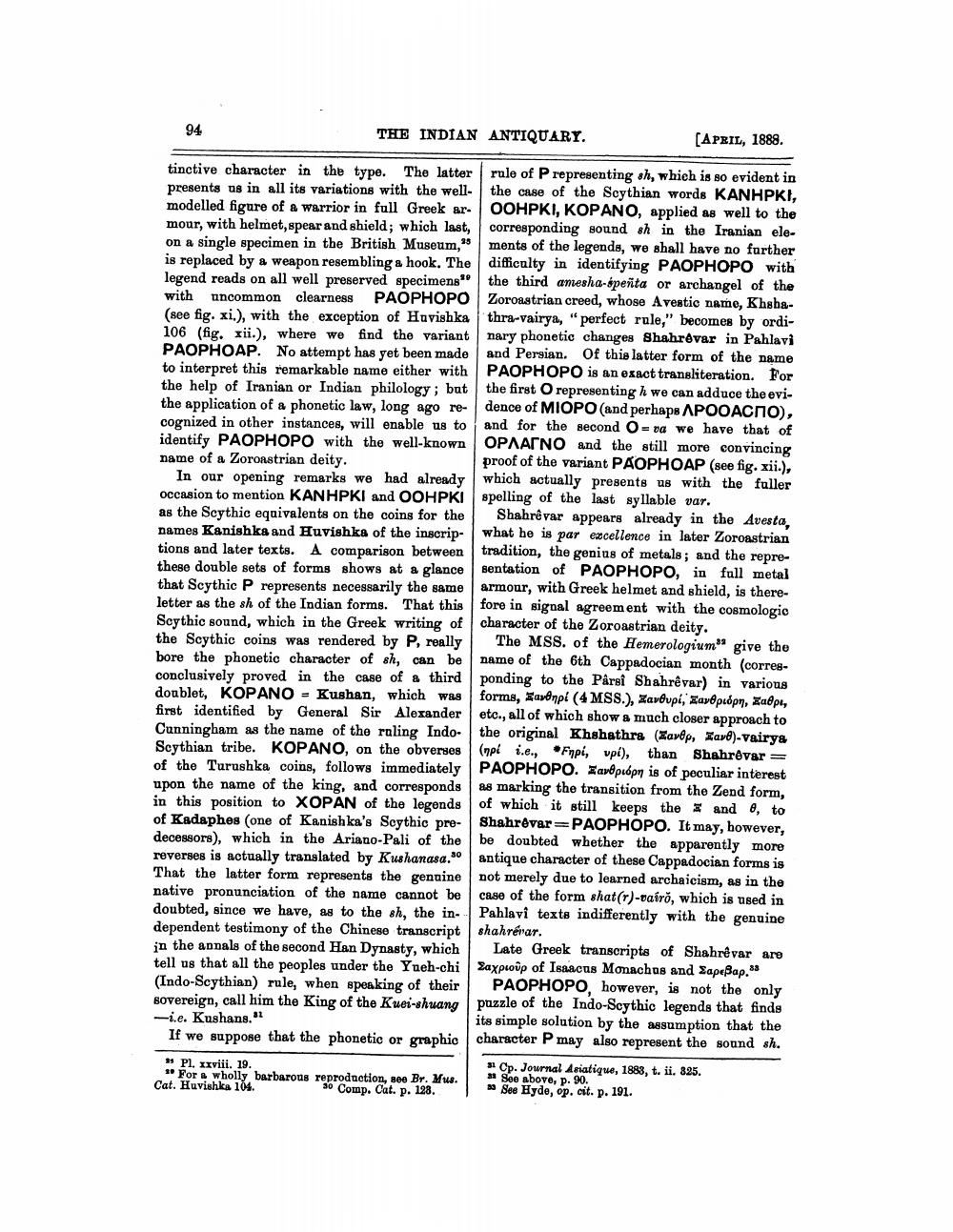________________
THE INDIAN ANTIQUARY.
[APRIL, 1888.
tinctive character in the type. The latter rule of P representing sh, which is so evident in presents us in all its variations with the well- the case of the Scythian words KANHPKI, modelled figure of a warrior in full Greek ar-OOHPKI, KOPANO, applied as well to the mour, with helmet, spear and shield; which last, corresponding sound sh in the Iranian ele. on a single specimen in the British Museum," ments of the legends, we shall have no further is replaced by a weapon resembling a hook, The difficulty in identifying PAOPHOPO with legend reads on all well preserved specimens" the third amesha-spenta or archangel of the with uncommon clearness PAOPHOPO Zoroastrian creed, whose Avestic name, Khsha(see fig. xi.), with the exception of Huvishkathra-vairya, "perfect rule," becomes by ordi106 (fig. xii.), where we find the variant nary phonetic changes Shahrdvar in Pahlavi PAOPHOAP. No attempt has yet been made and Persian. Of this latter form of the name to interpret this remarkable name either with PAOPHOPO is an exact transliteration. For the help of Iranian or Indian philology; but the first representing h we can adduce the evithe application of a phonetic law, long ago re-dence of MIOPO (and perhaps APOOACNO), cognized in other instances, will enable us to and for the second Ora we have that of identify PAOPHOPO with the well-known OPAANO and the still more convincing name of a Zoroastrian deity.
proof of the variant PAOPHOAP (see fig. xii.), In our opening remarks we had already which actually presents us with the fuller occasion to mention KANHPKI and OOHPKI spelling of the last syllable var. as the Scythic equivalents on the coins for the Shahrê var appears already in the Avesta, names Kanishka and Huvishka of the inscrip- what he is par excellence in later Zoroastrian tions and later texts. A comparison between tradition, the genius of metals; and the reprethese double sets of forms shows at a glancesentation of PAOPHOPO, in full metal that Scythic P represents necessarily the same armour, with Greek helmet and shield, is thereletter as the sh of the Indian forms. That this fore in signal agreement with the cosmologic Scythic sound, which in the Greek writing of character of the Zoroastrian deity. the Scythic coins was rendered by P, really The MSS. of the Hemerologiumo give the bore the phonetic character of sh, can be name of the 6th Cappadocian month (corresconclusively proved in the case of a third ponding to the Pârsi Shahrêvar) in various doublet, KOPANO - Kushan, which was forms, avonpi (4 MSS.), Zavoupl, Xav@popn, Eap, first identified by General Sir Alexander etc., all of which show a much closer approach to Cunningham as the name of the ruling Indo- the original Khshathra (Xav@p, Zave)-vairys Scythian tribe. KOPANO, on the obverses (opi i.e., Frpi, vpi), than Shahr@var = of the Turushka coins, follows immediately PAOPHOPO. Xav@puópn is of peculiar interest upon the name of the king, and corresponds as marking the transition from the Zend form, in this position to XOPAN of the legends of which it still keeps the and 8, to of Kadaphes (one of Kanishka's Scythic pre- Shahrdvar=PAOPHOPO. It may, however, decessors), which in the Ariano-Pali of the be doubted whether the apparently more reverses is actually translated by Kushanasa." antique character of these Cappadocian forms is That the latter form represents the genuine not merely due to learned archaicism, as in the native pronunciation of the name cannot be case of the form shat(r)-vairo, which is used in doubted, since we have, as to the sh, the in- Pahlavi texts indifferently with the genuine dependent testimony of the Chinese transcript shahrerar. in the annals of the second Han Dynasty, which Late Greek transcripts of Shahrêvar are tell us that all the peoples under the Yueh-chi Saxproüp of Isaacus Monachus and Sapeßap. (Indo-Scythian) rule, when speaking of their PAOPHOPO, however, is not the only sovereign, call him the King of the Kuei-shuang puzzle of the Indo-Scythic legends that finds -i.e. Kushans."
its simple solution by the assumption that the If we suppose that the phonetic or graphic character P may also represent the sound sh.
» Pl. xxviii. 19.
** For a wholly barbarons reproduction, see Br. Mus. Cat. Huvishka 104.
30 Comp. Cat. p. 128.
1 Op. Journal Asiatique, 1883, t. ii. 325. * Soe above, p. 90. " See Hyde, op. cit. p. 191.




